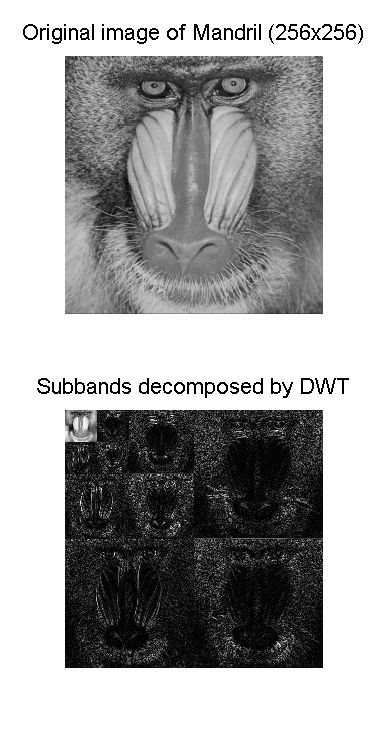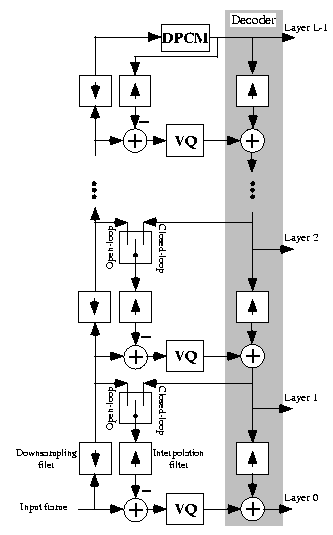In critically sampled pyramid coding, the image spectrum is decomposed into
subbands by analysis filters. The filtered signal is then subsampled by a
factor of 2 such that the cascaded decomposition operation results in the same number of
samples as that of the original image. Due to the delaying property of the
typical image spectrum from low frequency to high frequency, the decomposition
produces subbands with flatter spectrum. Encoding these subbands with greatly
reduced statistical correlation improves the coding efficiency according to
the rate distortion theory [4].
In this work we choose the octave-band decomposition over the uniform decomposition.
Since the decay of the typical spectrum is more rapid at lower frequencies,
the former yields subbands with even flatter spectrum by dividing lower bands
further into smaller bandwidth. Discrete Wavelet Transform (DWT) is a common
method to implement octave subband decomposition, which has been employed
in this work for critically sampled pyramid coding. Fig. 1 shows the original
image and the signal decomposed by analysis filters cascaded
in three levels, which results in ten subbands. The lowest band is shown
at the top left corner in the bottom image in
Fig. 1 , where the energy is mostly concentrated.

Besides critically sampled pyramid, overcomplete pyramid decomposition technique
is frequently used. This was introduced as a simple, yet powerful image
representation scheme by Burt and Adelson [7]. From the original image, a low-resolution
version is derived, then the original is predicted based on the coarse version, and
the difference is calculated between the original and the prediction.
At the decoder, the prediction is simply added back to the difference. Of course,
the process can be iterated on the coarser version. Fig. 2 shows 3-layered
over-complete pyramid. The upper one is the coarser version and the other two are
prediction error signals.

A shortcoming of this scheme is the oversampling, in other words, the number of encoded pixels is greater than that in the original image. Assume we start with an
![]()
The benefit of the oversampled pyramid comes from the fact that arbitrary filters (including nonlinear ones) can be used, and that visually pleasing coarse versions are easy to obtain by choosing unconstrained filters for decimation and interpolation. We tried three different filters: Gaussian filter as in the original Burt and Adelson scheme [7], simple averaging and bilinear interpolation filter suggested in [3], and Chebyshev type I lowpass filter generated by Matlab built-in functions "decimate" and "interp". Gaussian filter is used for later experiments to be shown since it gives the best rate-distortion performance among the three, which is illustrated in Fig. 3.

In this work we implement both open-loop and closed-loop pyramid structure introduced in [3]. The block diagram of N-layer pyramid codec is shown in Fig. 4 which is taken from [3].

In both critically sampled pyramid and oversampled pyramid, quantization
is performed on the coefficients of subbands or the error signals of the
over-sampled layers to compress the signal. In order to encode the
image with maximum efficiency, different bit rates should be assigned to each
subband or layer, depending on its statistical property. Here we will first
review the bit allocation scheme in an analytical way and then discuss
a "greedy" algorithm used in practice.
3.1 Analytical solutions
We denote the allocated bit rate per pixel in layer l or subband l by rl, then the bit rate for the image is
![]()
where
![]()
![]() .
(2)
.
(2)
To have the minimum distortion given the bit rate constrain r, one can obtain
![]() , and
, and
![]()
According to the detailed analysis in [3], the optimal bit allocation for subband l in the critically sampled case, or layer l in the open-loop oversampled case is
![]()
where
![]() ,
,
![]() is the power transfer factor,
is the power transfer factor,
![]() is the spectral
flatness and
is the spectral
flatness and
![]() is the variance of the interpolation error signal.
is the variance of the interpolation error signal.
For the closed-loop oversampled case,
 where
where
 .
(5)
.
(5)
From the above, (4) and (5) are the analytical forms we follow in our simulations for bit allocation.
3.2 The "greedy" algorithm
The problem with the analytical bit allocation scheme is that the rates might be noninteger or negative [2]. Another algorithm tackles the bit allocation problem by directly following (3), independent of any analytical form of the image statistics. That is, at each time, allocating one more bit to the subband or layer which results in the maximum reduction in distortion. This iteration will continue until the all the bits under the constraint have been consumed. This scheme is usually called the "greedy" algorithm. It is not optimal, since by allocating one bit to each subband or layer at each time, the relationship in (3) is not guaranteed when the iteration stops. This algorithm is applicable in practice though. We will show the performance by these two algorithms in the next section.






